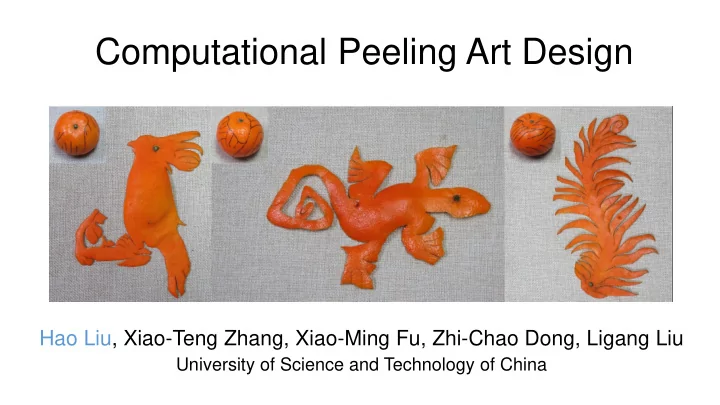

Computational Peeling Art Design Hao Liu, Xiao-Teng Zhang, Xiao-Ming Fu, Zhi-Chao Dong, Ligang Liu University of Science and Technology of China
Peeling art design
Popular art form
Peeling art examples
Yoshihiro Okada’s method
Peeling art design problem
Challenges of the computational method • Non-trivial to optimize the similarity • Unsuitable input shape
Existing work: cut generation • Minimum spanning tree method [Chai et al. 2018; Sheffer 2002; Sheffer and Hart 2002] • Mesh segmentation approaches [Julius et al. 2005; Lévy et al. 2002; Sander et al. 2002, 2003; Zhang et al. 2005; Zhou et al. 2004] • Simultaneous optimization [Li et al. 2018; Poranne et al.2017] • Variational method [Sharp and Crane 2018]
Existing work: cut generation • Minimum spanning tree method [Chai et al. 2018; Sheffer 2002; Sheffer and Hart 2002] • Mesh segmentation approaches [Julius et al. 2005; Lévy et al. 2002; Sander et al. 2002, 2003; Zhang et al. 2005; Zhou et al. 2004] • Simultaneous optimization [Li et al. 2018; Poranne et al.2017] • Variational method [Sharp and Crane 2018] unfolded shapes ≠ input shapes
Our approach Cut generation
Key idea Cut generation Difficult Mapping computation Easy
Mapping computation 𝑆 Φ Input 𝑇 𝑇 𝑛 = Φ(𝑇) Two goals: min 𝐹 𝑗𝑡𝑝 𝑇 𝑛 , 𝑇 + 𝑥𝐹 𝑡ℎ𝑠 (𝑆) 1. Low isometric distortion 2. Area of 𝑆 approaches zero
Isometric energy • ARAP distortion metric [Liu et al. 2008] 𝑂 𝑔 2 𝐹 𝑗𝑡𝑝 𝑇 𝑛 , 𝑇 = 𝐵𝑠𝑓𝑏 𝑔 𝑗 ||𝐾 𝑗 − 𝑆 𝑗 || 𝐺 𝑗=1 𝑆 𝑗 is an orthogonal matrix
Shrink energy • Our novel rank-one energy 𝑂 𝑆𝑔 𝐵𝑠𝑓𝑏 𝑢 𝑗 ||𝐾 𝑗 − 𝐶 𝑗 || 𝐺 2 𝐹 𝑡ℎ𝑠 𝑆 = 𝑗=1 𝐶 𝑗 is a rank one matrix • Other choices 2 • Frobenius energy ||𝐾 𝑗 || 𝐺 • Determinant energy det 𝐾 𝑗 2 det 𝐾 𝑗 Input ||𝐾 𝑗 || 𝐺 rank-one
min 𝐹 𝑗𝑡𝑝 𝑇 𝑛 , 𝑇 + 𝑥𝐹 𝑡ℎ𝑠 (𝑆) Local-global solver 𝑡𝑢. 𝜖𝑆 = 𝜖𝑇 𝑛 and 𝑤 𝑛 , 𝑤 𝑆 ∈ 𝑁 Local step : 𝑂 𝑔 𝐹 𝑗𝑡𝑝 𝑇 𝑛 , 𝑇 = 2 𝑈 𝐵𝑠𝑓𝑏 𝑔 𝑗 ||𝐾 𝑗 − 𝑆 𝑗 || 𝐺 𝑆 𝑗 = 𝑉 𝑗 𝑊 𝑗 𝑗=1 𝑂 𝑆𝑔 𝑈 2 𝐶 𝑗 = 𝑉 𝑗 𝑒𝑗𝑏 𝜏 𝑗 , 0 𝑊 𝐹 𝑡ℎ𝑠 𝑆 = 𝐵𝑠𝑓𝑏 𝑢 𝑗 ||𝐾 𝑗 − 𝐶 𝑗 || 𝐺 𝑗 𝑗=1 Global step : 𝑜𝑓𝑥 = 𝑄(𝑤 𝑙 + 𝜀𝑤 𝑙 ) 𝑤𝑏𝑠𝑗𝑏𝑐𝑚𝑓𝑡 𝜀𝑤 𝑙 𝑗𝑜 tangent space 𝑤 𝑙 𝑘 𝑈 𝐺 𝑘 = 𝐺 𝑤 𝜀𝑤 𝑙 𝜀𝑤 𝑙 𝑗𝑜 𝐺 𝑘 𝑗𝑡 𝜀𝑤 𝑙 𝑙 𝑙
Some details Representations of M stalk locations
Suitable input
Unsuitable input
Iterative interaction Mapping Process Almost cover Final resulting cut Iterative design Cut Generation Interaction Process
Interaction place Prune and Unfold 𝑇 𝑛 and 𝑆 Decompose
Interaction 1: shape augmentation
Interaction 2: part deletion
Interaction 3: angle augmentation
Interaction 4: curvature reduction
Interaction 5: pre-processing Input Input Unprocessed Processed with specify area high distortion low distortion
Interaction 5: pre-processing Input with specify area Unprocessed: high distortion Align to initialize Processed: low distortion
Cut generation Mapped shape Resulting cut Simplify boundary
Real peeling
Real design
Real peeling
Experiments
Shapes designed by Yoshihiro Okada
Comparison to Yoshihiro Okada Okada’s Ours Dove Eagle Shrimp
Our results
More results
Conclusion • A computational tool for peeling art design and construction. • Unsuitable input 2D shapes are rectified by an iterative process.
Limitations: conservation principle … User input Interaction many times also cannot keep posture
Thank you
Recommend
More recommend